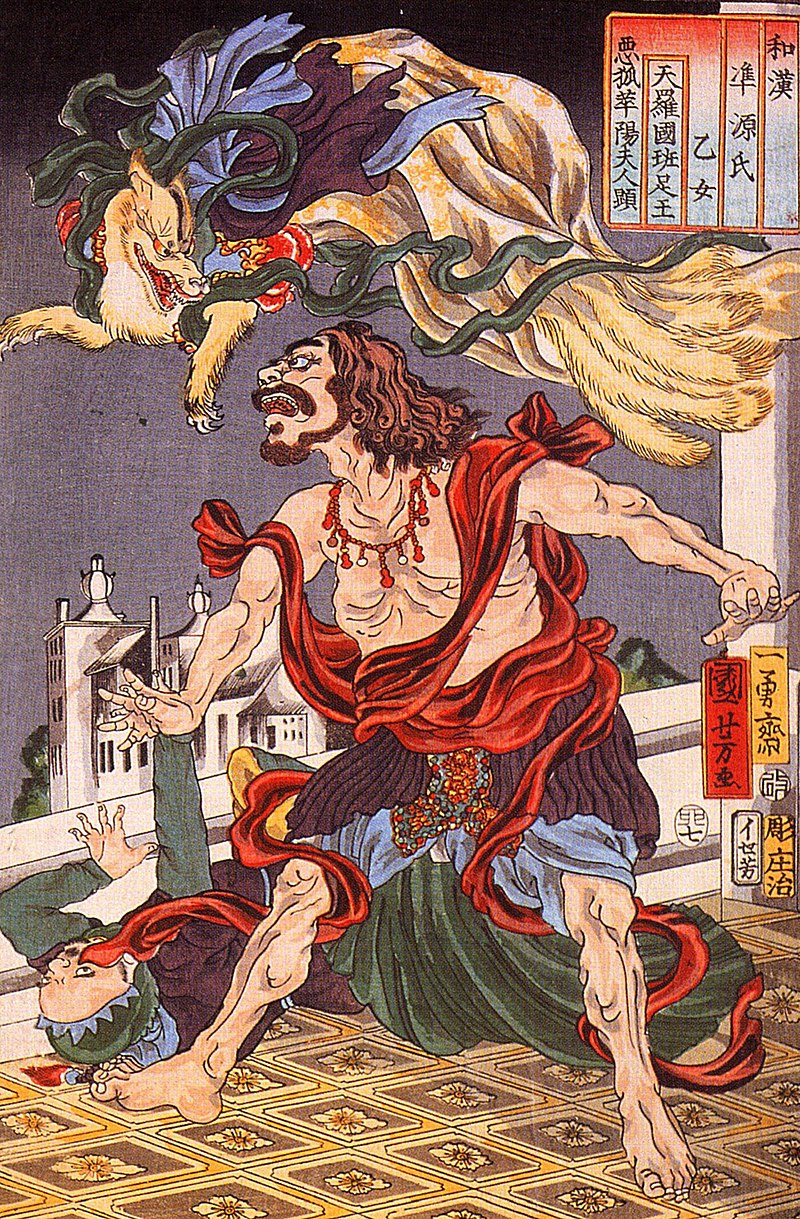From my research, I was able to choose which creatures I wanted to base my projects on. I decided to go three folklore creatures that are described to be Yokai’s*. As these creatures have the ability to shapeshift into humans I thought it would be interesting to recreate them as anthropomorphic characters rather than recreating a stylised version of the animals. Based on the research I will highlight the various characteristics that will be important to include within my character design.
Yōkai
are a class of supernatural monsters, spirits and demons in Japanese folklore. The word yōkai is made up of the kanji for “bewitching; attractive; calamity;” and “spectre; apparition; mystery; suspicious”. They can also be called , , or . Yōkai range eclectically from the malevolent to the mischievous, or occasionally bring good fortune to those who encounter them. Often they possess animal features (such as the Kappa, which is similar to a turtle, or the Tengu which has wings), other times they can appear mostly human, some look like inanimate objects and others have no discernible shape. Yōkaiusually have a spiritual supernatural power, with shapeshifting being one of the most common. Yōkai that have the ability to shapeshift are called obake.
Japanese folklorists and historians use yōkai as “supernatural or unaccountable phenomena to their informants”. In the Edo period, many artists, such as Toriyama Sekien, created yōkai inspired by folklore or their own ideas, and in the present, several yōkai created by them (e.g. Kameosa and Amikiri, see below) are wrongly considered as being of legendary origin. (Wikipedia, n.d.)
Kitsune
Kitsune ( 狐) is the Japanese word for the fox. Within Japanese mythology, they’re believed to have supernatural abilities. Stories depict them as intelligent beings and as possessing paranormal abilities that increase with their age and wisdom. According to Yōkai folklore, all foxes have the ability to shapeshift into human form. While some folktales speak of kitsune employing this ability to trick others—as foxes in folklore often do—other stories portray them as faithful guardians, friends, lovers, and wives.

Foxes and humans lived close together in ancient Japan; this companionship gave rise to legends about the creatures. Kitsune have become closely associated with Inari, a Shinto kami or spirit, and serve as its messengers. This role has reinforced the fox’s supernatural significance. The more tails a kitsune has—they may have as many as nine—the older, wiser, and more powerful it is. Because of their potential power and influence, some people make sacrifices to them as to a deity.
On the other hand, foxes were often seen as “witch animals”, especially during the superstitious Edo period (1603–1867), and were goblins who could not be trusted (similar to some badgers and cats).
Kitsune are commonly portrayed as lovers, usually in stories involving a young human male and a kitsune who takes the form of a human woman. The kitsune may be a seductress, but these stories are more often romantic in nature. Typically, the young man unknowingly marries the fox, who proves a devoted wife. The man eventually discovers the fox’s true nature, and the fox-wife is forced to leave him. In some cases, the husband wakes as if from a dream, filthy, disoriented, and far from home. He must then return to confront his abandoned family in shame.
Many stories tell of fox-wives bearing children. When such progeny are human, they possess special physical or supernatural qualities that often pass to their own children. The astrologer-magician Abe no Seimei was reputed to have inherited such extraordinary powers.
Other stories tell of kitsune marrying one another. Rain falling from a clear sky — a sunshower — is called kitsune no yomeiri or the kitsune’s wedding, in reference to a folktale describing a wedding ceremony between the creatures being held during such conditions. The event is considered a good omen, but the kitsune will seek revenge on any uninvited guests.
Characteristics
There are two different categories of foxes, Zeko and Yako:.
- Zenko (善狐-literally good foxes) are the friendly foxes that are associated with the God Inari, and are usually called “Inari foxes”.
- Yako (野狐, literally field foxes, also called nogitsune) are the evil mischievous foxes that trick and deceive humans and are afraid of zeko foxes.
Kitsunes are noted for having as many as nine tails (Smyers, 1999). Usually, the greater number of tails indicates an older and more powerful fox, in some folktales, it states that a fox will only grow additional tails after it has lived 100 years, once a fox gains its ninth tail its fur becomes white or gold. These foxes gain the ability to see and hear anything happening in the world. After reaching 1000 years old after gaining its ninth tail and turn into a golden colour it then acends into the heavens.
Shapeshifting

A kitsune may take human form once the fox has reached 100 years old. As a common prerequisite for the transformation, the fox must place reeds, a leaf, or a skull over its head. (Nozaki, 1961, p. 78) Common forms assumed by kitsune include beautiful women, young girls, elderly men, and even young boys. These shapes are not limited by the fox’s age or gender, and a kitsune can duplicate the appearance of a specific person. Foxes are particularly renowned for impersonating beautiful women.
Bakedanuki
Tanuki (狸 or たぬき) in Japanese, is a subspecies of the Asian racoon dog. In Japanese folklore, Bake-danuki (化け狸) are a kind of tanuki yōkai (ghost) found in the classics and in the folklore and legends of various places in Japan.
The inspiration for the magical Tanuki is believed to come from China, where people believed in god-like, shape-shifting wildcats, usually leopards. Because Japan didn’t have any animals quite like the fearsome leopard, Japanese scholars transferred the power to other creatures like stray cats, badgers, weasels, and even wild boars. Eventually, the Fox and the Raccoon Dog became the most popular vessels for these magical powers, and they were revered as gods who ruled over nature.
When Buddhism took root in Japan, deifying animals began to be seen as primitive. Only animals like foxes and snakes, who were associated with the gods, could be thought of as powerful. The Raccoon Dog, who was once treated like a god, became a bumbling trickster with laughable powers.

Characteristics
The tanuki of Japan from time immemorial were deified as governing all things in nature, but after the arrival of Buddhism, animals other than envoys of the gods (foxes, snakes, etc.) lost their divinity. Since all that remained was the image of possessing special powers, they were seen as evil or as yōkai, with tanuki being a representative type.
Tanukis, who are gifted with magical power, have eight special traits that differentiate them from their common brethren. They wear a wide-brimmed hat to protect themselves from bad luck and bad weather. They hold a bottle of sake, a popular alcohol made of rice, in one hand, which symbolizes virtue, and in the other hand, they hold a promissory note which symbolizes trust. They have large eyes to survey their world and make decisions, big fluffy tails to give them strength and agility, large scrotums which represent wealth, and a large stomach which symbolizes tranquillity and decisiveness. Finally, they wear a playful, friendly smile, inviting humans to join them in their games.

Shapeshifting
Compared with kitsune, which are the epitome of shape-changing animals, one saying is given that “the fox has seven disguises, the tanuki has eight (狐七化け、狸八化け)”. The tanuki is thus superior to the fox in its disguises, but unlike the fox, which changes its form for the sake of tempting people, tanuki do so to fool people and make them seem stupid. Also, a theory is told that they simply like to change their form.
Both the fox and the tanuki can fool you into thinking they’re human. But each has a different favourite disguise. There are stories of tanuki doing the classic kitsune illusion, pretending they’re a beautiful woman and seducing a man who wakes up the next morning in a pile of leaves in the middle of the woods. But the tanuki’s favourite disguise is that of a Buddhist monk. So much so there’s a name for the tanuki disguised this way: tanuki-bōzu 狸坊主.
Bakeneko
The bakeneko (化け猫, “changed cat”) is a type of Japanese yōkai, or supernatural creature. According to its name, it is a cat that has changed into a yōkai.
